By: Rick Landers
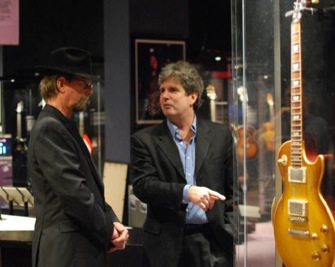
Roger McGuinn (left) and HP Newquist (right)
Walk in to the National GUITAR Museum‘s traveling exhibit, “GUITAR: The Instrument that Rocked the World”, and you find yourself surrounded by a troupe of intriguing guitars that captivate and urge you to play.
The road show changes each time it hits a new town since the museum’s founder, HP Newquist, wants to not only inform, but to surprise. The National GUITAR Museum and the exhibit are both part of a vision Newquist to promote his favorite musical instrument – the guitar.
Creative vision is nothing new to Newquist, who has authored a host of fine books that have explored a wide range of subjects, including Legends of Rock Guitar (with Peter Prown), The Way They Play
series (including Blues Masters, Hard Rock Masters, Metal Masters, and Acoustic Masters), with Richard Maloof and the award winning The Great Brain Book: An Inside Look At The Inside Of Your Head.
In 2012, HP released a fascinating book called, The Book of Blood – From Legends & Leeches to Vampires to Veins.
HP is the former Editor-in-Chief of Guitar Magazine as well as writing Going Home, a Disney Channel documentary, featuring Robbie Robertson, and directing the film documentary, John Denver – A Portrait.
******
Rick Landers: Your traveling exhibits have been underway for almost two years. What kind of traction are you getting?
HP Newquist: Well, as of this summer, we’ll have been on the road two full years. By all accounts, we’ve had about half a million people come through it in that period.
We’ve been more successful than we expected, because now we’re actually booked fully for the next two years. So, we must be doing something right.
Now that we see there is an attraction that people kind of take to this in a big way, we really do feel like the original idea – which, as you know, started primarily as something we thought would be a good idea – has now been proven to be a good idea. We’re really committed to making not only the traveling exhibit go forward, but to start laying plans for the permanent home for museum.
Rick: Do you think that at some point you’ll have both the permanent museum and the traveling roadshow?
HP Newquist: I think we probably will. The plan is to have the traveling exhibit on the road at least through the next three or four years, which will allow us to cover an even greater amount of territory across the country.
It will also give us a chance to check out different cities throughout the country. I think that once we do have a permanent museum, that there’s nothing to keep us from putting a smaller tour out there, so that even people who can’t make it to the permanent museum still have the opportunity to see some of these incredible guitarists.
Rick: I think that’s a great model for you.

A “Frying Pan” guitar designed by George Beauchamp circa 1931.
HP Newquist: I’m hoping so. [Laughter]
Rick: You’ve got a few museum partners and sponors, right?
HP Newquist:. We do have partners, people who we work closely with on various elements of the museum. For instance, Mojotone Amps have helped us create all of the video displays, which actually needed inside amp cabinets.
DGN Custom Guitars has helped us maintain instruments and has created a couple of specific guitars for the exhibit. We’re also working with Fender, doing some giveaways and promotions.
Each of our partners brings something specific to the table, but currently there are no sponsors, in terms of underwriters or funding, for the exhibit. That is something that we’re going to be looking at, starting the middle of this year.
Rick: Have you considered grants?
HP Newquist: When we started, we looked at everything from government grants and grants from private industry and found out that it was really very constraining and very restrictive, in terms of how you could actually run an operation.
After approaching a number of nonprofits and looking at a couple of government funding possibilities, it made more sense to not request any of those funds, because they would have had a certain level of say in how the funding was used.
I felt, as did as some of my partners, that if we could do it with private funding, that we’d have a much better chance of creating the kind of museum exhibit that we really envisioned, without stipulations in regard to we’ve got to address this in order to make the financiers happy.
By not having to make anyone else happy, we could really focus on what we thought would be the very best guitar exhibit and the thing that would appeal to the greatest number of people.
Rick: Does the exhibit change or evolve each time you make a move?
HP Newquist: It does change. Every venue is completely different.
We’ll swap out certain instruments, depending on the market or depending on the city we’re in. Maybe we’ll focus a little more on acoustic instruments, as opposed to electric instruments. We’ve added more interactives and more videos of each market.
Also the host museums tend to dictate some of those changes themselves. For instance, we’re currently in Springfield. And the Springfield museum is a complex of four different museums, all on the same quadrangle.
But. we’ve split up our exhibit half between a fine arts museum and a science center. So, we’ve moved a lot of the vintage and antique instruments to the fine arts museum and then put more of the interactives and the cooler, new design-type guitars in the science center.
Rick: When new visitors come to the exhibit what can they expect to see or experience?
HP Newquist: One of the things that we really wanted to have every single person who comes through to get a sense of is just how engaging the exhibit is.
There are a number of things we focused on in making this an engaging exhibit for everyone.
First of all was the guitars themselves, which are obviously eye candy for not only guitarists and for people who appreciate music and appreciate design, but we’ve also brought a really strong sense of science and history to the exhibit There’s the history of stringed instruments that led up to the invention of the guitar. Then there’s the evolution of the guitar itself from post Middle Ages up to the creation of the first six-stringed guitars in the late 1700s and the invention of the electric guitar in the 1930s and on up.
So, it’s a nice history and also has a pop culture element because at each step along the way, the guitar had an influence on the music of the day. The exhibit presents a really unique way to learn about science in a way that people don’t even realize that they’re learning about science.
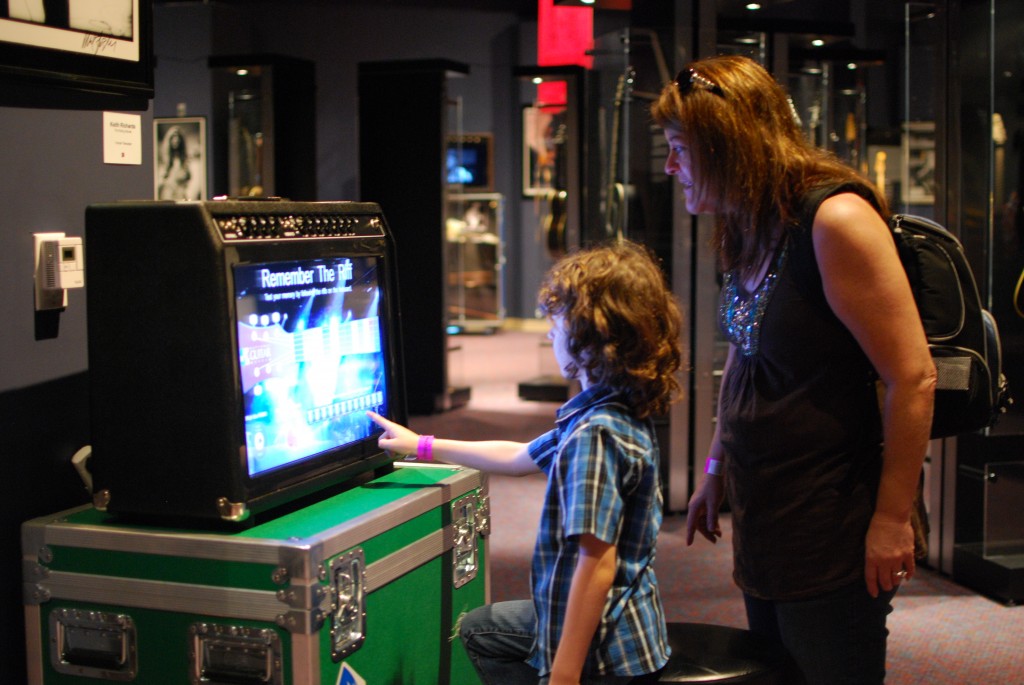
An interactive amp display at the NGM exhibit.
We’ve created interactives that show how pickups work, which teaches electromagnetism. We‘ve created an interactive about how amplifiers work, which teaches people about sound waves and the physics of sound. We’ve created interactives that show how much force the top of an acoustic guitar can withstand in we ask visitors if they can withstand the same amount of force that’s on a thin piece of spruce over the top of an acoustic guitar.
There’s almost 20 of those kinds of interactives that teach people about science, so everybody from kids to adults can go to the exhibit and get something out of it, not only in terms of eye candy, but in terms of some stealth learning that they can walk away and say, ”Hey, I didn’t know that.”
People who have never been exposed to the guitar, are often confused by the term “luthier”. We have a luthier’s workbench, and we explain that luthier comes from the word “lute” and that even today you know these people aren’t making lutes – their making guitars – they’re still referred to as luthiers. So, even if they just want to come in and say, “Oh, yeah, I know what a luthier is now, they’ve learned something above and beyond how cool guitars are.
Rick: You’ve used the phrase “stealth learning”.
HP Newquist: Yeah. I find that when I give personal tours. People will say exactly what I’ve just said, which is “Oh, I didn’t know that,” or “That’s interesting. How old is that?”
The first six-string guitar was created about the time of George Washington. They’re surprised by that. We’re not trying to force anyone to learn and we’re not even telling them to learn something, but they do learn it and under the radar, and there is a sort of stealth learning that goes on. That makes the experience all that more valuable.
Rick: Is that stealth learning or is that stealth teaching? [Both laugh]
HP Newquist: It’s a number of things. We call it stealth science and stealth history, which is what we’re presenting. Our presentation of it is stealth teaching and the fact that they’re not aware of learning it makes it stealth learning. [Laughing]
Everything is very stealthy, top to bottom.
Rick: But, it works.
HP Newquist: It does.
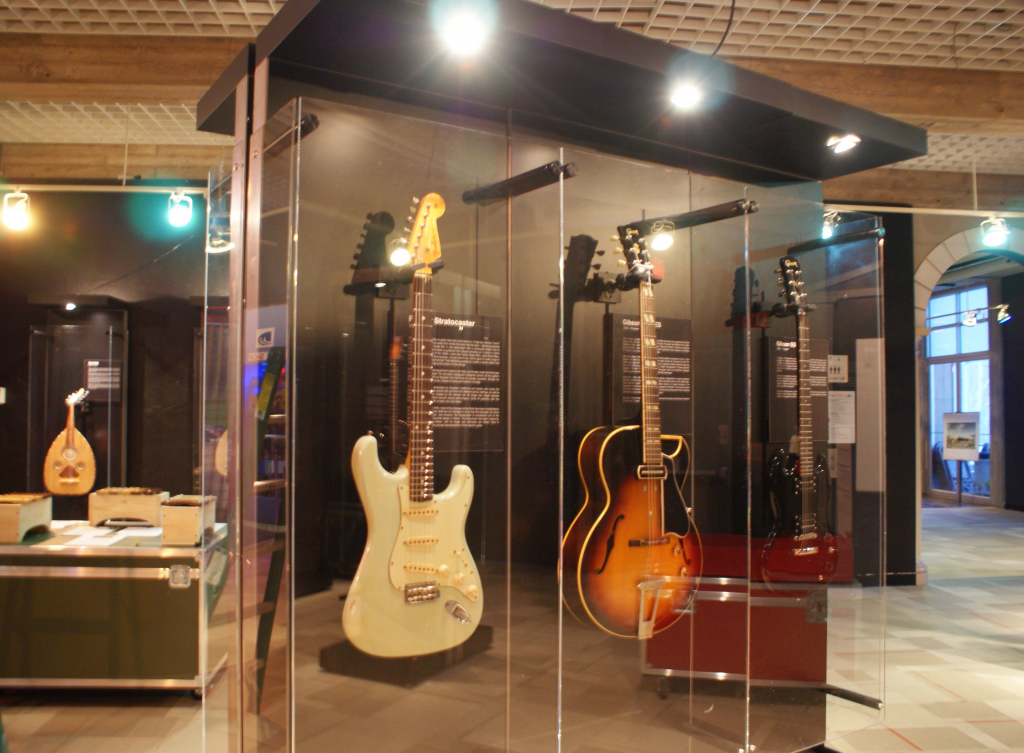
Rick: When you’re walking in the museum and seeing some of these instruments, like the early Martin D-28, do you ever get the urge to grab them and give ‘em a go?
HP Newquist: Yeah. I’ve done it. I’ve given most of them enough personal time that I’ve already chosen the ones I like to play, and the ones that are perhaps much better looked at than actually played. There are certainly times when we’re either setting up or tearing down the exhibit where I will take some time with a particular guitar and just play it for the sheer joy of playing.
I do have the opportunity to take them out for a spin, as it were. There are also days – you know we have more than 80 instruments and you just look at them and go, “Too many guitars, too little time.”
Rick: [Laughing] And sometimes you have one guitar and there’s too little time, unfortunately.
HP Newquist: Exactly!
Rick: Given your original vision to plant the exhibit at a permanent spot, did it surprise you that it were so successful relatively quickly, getting the traction that we talked of earlier?
HP Newquist: As I said at the outset, we’re incredibly pleased by the success. It’s been more successful than we initially expected. Our original plan was to be on the road about four or five years and really kind of take stock of where we’d been, and determine where we wanted to be going in the future.
Response from cities all over the U.S. has led us to conclude that maybe there are a few more cities that we should squeeze in to that initial projection, in order to make sure that we’re not selling ourselves short. But, also giving ourselves a chance to reach that much more of the population and make them aware of what we’re doing before we do actually put down permanent roots. The success has kind of elongated the process. At the same time, it’s let us make more people aware of what we’re doing.
Rick: Have you found that museum directors are asking you to come back?
HP Newquist: We’ve actually had several of the venues we’ve been to so far say they’d be more than happy to have us come back in the space of four to five years with exactly the same exhibit we had, simply because of the success they experienced.
With everything we’ve been through, there’s been an average of 30% increase in their attendance over the course of the time we’ve been there. They’re pleased that the guitar is attracting so much attention, which is something we’d hoped would happen.
I think the community response has shown that people are looking for something interesting to go see and to go experience that they can relate to. The guitar is certainly something that most of us can relate to.
Rick: Sounds like you’re at least a temporary magnet to pull people in. You have that 30% who are coming expressly to see the exhibit and they bleed into other areas of the museum and make it that much more of a welcoming place.
HP Newquist: Exactly. When we were in Pittsburgh at the Carnegie Science Center, they laughingly referred to us as their gateway exhibit, which is king of a takeoff on “gateway drug”.
People would come in to see the guitar exhibit who hadn’t been to the museum in years, or maybe had never been at all. They would come in to experience what guitar had to offer, but since they were in the building, they would then visit other sections of the building. They would find things they felt were worth coming back to see again.
So, the gateway exhibit is happy to draw attention to any host that happens to have us for any length of time.
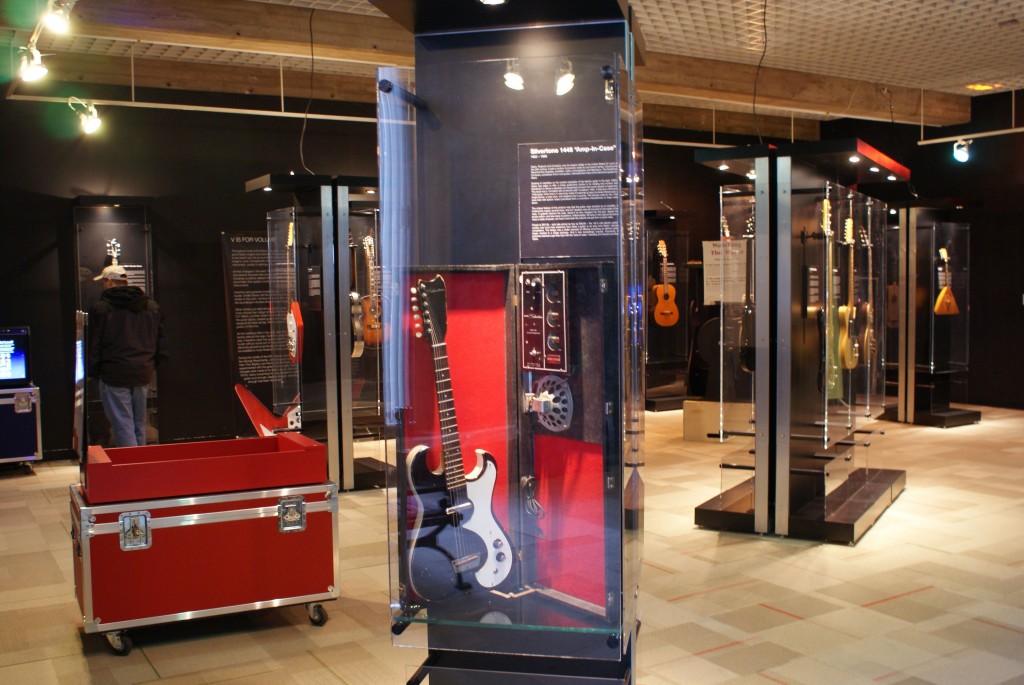
Rick: Our readers who don’t live in the states will wonder if you have any plans to get this show on the road internationally.
HP Newquist: We do. We’ve been approached by a couple of museums in the U.K. and a couple in Asia to customize the exhibit for international taste. We’re hoping to have something to announce about that by the end of this year.
Rick: You, personally, seem to always have a full platter of projects percolating. I know you’ve got books and a few other projects going on most of the time. Along with the exhibit, what else is filling up your time at this point?
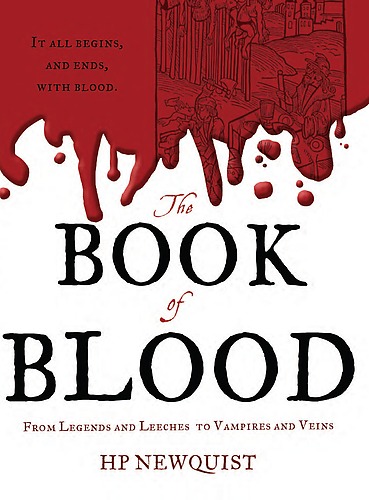 HP Newquist: I’m working on three different books. I am currently looking at doing an exhibition based on one of those books, which I can’t talk about now.
HP Newquist: I’m working on three different books. I am currently looking at doing an exhibition based on one of those books, which I can’t talk about now.
I should just keep it simple and say. For now, in addition to making sure the museum is constantly growing and starting to look at plans for the permanent museum, my writing continues to keep me extremely busy. I’ve got three more books due by the end of this year.
I remember the first time when I wrote a book on the brain and I met a brain surgeon, I found out that he did on an average of four to five days a week five neurosurgeries a day. That’s an average of 25 a week for roughly forty weeks a year. And he had been a neurosurgeon for 30 years.
So, when we started doing the numbers, he had done thousands upon thousands of brain surgeries. I asked how that can be possible. He said, “It’s just like I start at 6:30 in the morning and I finish about 3:00 or 4:00 in the afternoon. Each surgery takes X number of hours and that’s what I do day in and day out.”
I was amazed. You’d think, oh, how many neurosurgeries can one guy do in his life, and you’d think, “Oh, maybe a couple of hundred.” Some of these guys do tens of thousands.
So, then I think of what you just said, “Oh, it’s impressive that you’ve got these things going.” Three books, well, that’s just an average year. I look at Isaac Asimov who accomplished hundreds of books in his lifetime and it makes me feel like a slacker.
Rick: Well, I’m still conceiving my first book. [Both laugh]
HP Newquist: Well, it does take a while to get up and running, but once you get the first one under your belt, you’ve got the engine into first gear. All you have to do is keep pushing the accelerator pedal.
Rick: Maybe it’s like a high dive. Maybe it’s a little easier the second and third time.
HP Newquist: I’ve never done that. I’m not a good heights person. I’ve bungee jumped once, but I’m not sure the second time would be any better than the first time, because it’s not a skill you learn. So, I’d rather not be jumping off high dives even the first time. [Both laugh]
Rick: How do you develop ideas to keep your exhibit fresh? Where do they come from?
HP Newquist: Part of any expansion or any innovation we do within the exhibit, comes from the familiarity that we have with it.
When I go and see it whatever location it’s set up in, I’m already fairly familiar with it, obviously, because I’ve lived with it for a couple of years. Then I find things that I think could be improved upon – that there might be a more interesting guitar for guitar players; maybe a more interesting guitar for non-guitar players to learn about. It really comes down to continual immersion into the exhibit.
Then we read the things that people post on our Facebook page. We go to trade shows like NAAM. We talk to our advisers, and we’ve got a great board of advisers, both excellent guitarists and industry people. Continuing to bounce things off those people, gives us a sense of what’s currently happening, and we can weigh that against what we have had in the exhibit up until now. It gives us a way to enhance the exhibit at every stop on the way.
I don’t want to say we reimagine it or reenvision it, because at the core, the exhibit is always about the guitar, and that never changes. We do make tweaks and we do make modifications, and all those factors I just mentioned come into play.
NATIONAL GUITAR MUSEUM IN HAWAII! | Benedetto Guitars (9 years ago)
[…] Special thanks to National Guitar Museum Executive Director HP Newquist for recent photos of the Benedetto Guitars workbench at the NGM’s current exhibition in the […]